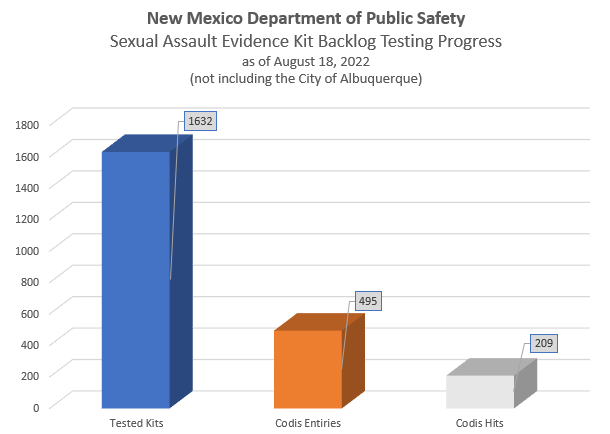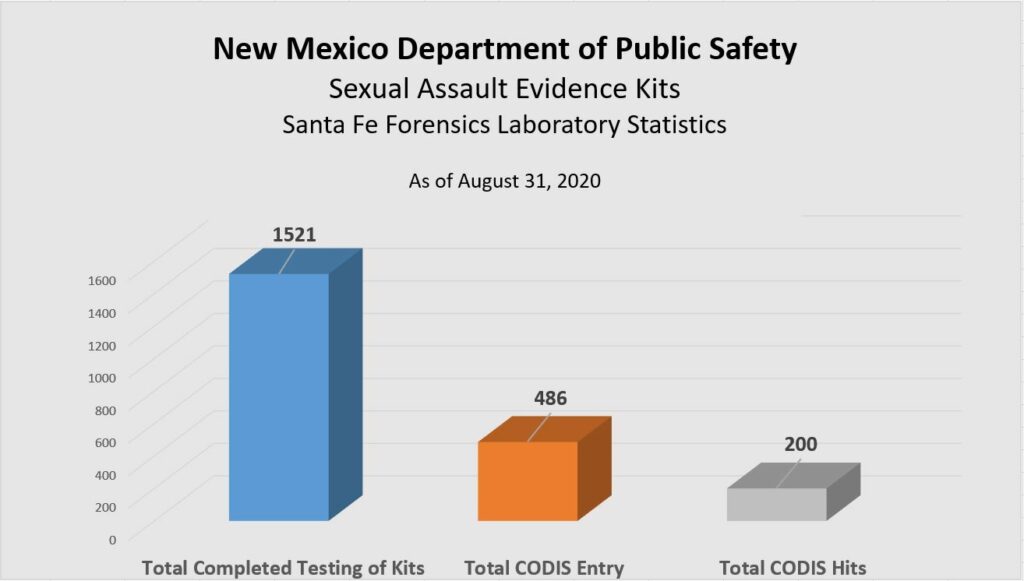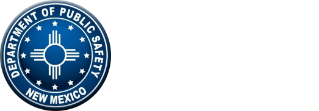New Mexico Sexual Assault Kit Initiative Program
- NMDPS Home
- Programs
- New Mexico Sexual Assault Kit Initiative Program
- LECB
- NMLEA
- NMLEA Events Calendar
- Director's Page
- Basic Police Officer Training (BPOT)
- Certification By Waiver (CBW)
- Public Safety Telecommunicator
- In-Service Training
- Satellite Academies
- Albuquerque Police Department (APD) Training Academy
- Bernalillo County Sheriffs Office (BCSO) Training Academy
- Central New Mexico (CNM) Law Enforcement Academy
- Dona Ana County Sherriff's Office (DASO) Training Academy
- Las Cruces Police Department (LCPD) Training Academy
- New Mexico State Police (NMSP) Training Academy
- San Juan Criminal Justice Authority
- Southeastern New Mexico Law Enforcement
- Western NM University Police Academy
- Forms & Documents
- NM Law Enforcement Standards & Training Council
- NM Law Enforcement Officer Memorial
- NMSP
- Law Enforcement Support Services
- Budget Bureau
- Financial Management Bureau
- Law Enforcement Records Bureau
- Grants Management Bureau
- Programs
- Coronavirus Emergency Supplemental Funding (CESF)
- Community Oriented Policing Services Anti-Methamphetamine Program
- DNA Capacity Enhancement For Backlog Reduction (CEBR) Program
- Edward Byrne Justice Assistance Grant Program
- High Intensity Drug Trafficking Area Program
- Law Enforcement Mental Health and Wellness Act Program
- Motor Carrier Safety Assistance Program (MCSAP)
- NM Sexual Assault Kit Initiative Program
- Paul Coverdell Science Improvement Program
- Post-Conviction Testing of DNA Evidence to Exonerate the Innocent Program
- Prison Rape Elimination Act Program
- Project Safe Neighborhood (PSN)
- Residential Substance Abuse Treatment Program
- Support for Adam Walsh Act Implementation Grant Program
- Traffic Safety
- Victim of Crime Act - Victim Advocacy Program
- Waste Isolation Pilot Plant (WIPP)
- Funding Opportunities
- Grant Guidance and Resources
- Careers
- Programs
- Forensic Laboratory Bureau
- Information Technology
- Equal Employment Opportunity Bureau
- What’s Happening
- Careers
National SAKI Social Media Feed
New Mexico Sexual Assault Kit Initiative Program
About
In 2016, the New Mexico Department of Public Safety received over $2 million in federal grant funding from the Bureau of Justice Assistance to support a coordinated effort to complete DNA testing of 1,500+ backlogged sexual assault evidence kits and to establish a statewide Sexual Assault Evidence Kit (SAEK) tracking system.
To date, this funding has been utilized to test kits, almost eliminating the backlog. It has also been crucial in New Mexico’s effort to provide specialized sexual assault training for law enforcement personnel, develop sexual assault policies and procedures, introduce new legislation supporting and providing vital resources to the survivors of sexual assault.
SAKI Program Coordinator / NM SAEK Tracking Website Support:
(505) 372-8351
The New Mexico Statewide Sexual Assault Evidence Kit Tracking System (SAEK Track)
The New Mexico Department of Public Safety launched a statewide sexual assault evidence kit tracking system (SAEK Track) in May 2020. The tracking system is administered by the New Mexico Department of Public Safety and can be accessed HERE.
DPS Tracking System Brochure
NM SAEK Track Brochure Accessible
NM SAEK Track Brochure Spanish
Statewide Sexual Assault Kit Initiative Multi-Disciplinary Team
The New Mexico Sexual Assault Kit Initiative Program has joined forces with executive administrators around the state to develop a multi-disciplinary team dedicated to addressing the pressing issues and needs surrounding sexual assault; from the investigation of cases and the provision of survivor services to the processing and handling of sexual assault evidence and victim notification. The New Mexico Department of Public Safety and the Multi-Disciplinary Team have been instrumental in accomplishing the following:
- A sample Law Enforcement Agency Policy, for the handling of sexual assault evidence by law enforcement and laboratories, was developed in compliance with 30-9-19 NMSA 1978. This policy has served as a model for other agencies.
- The New Mexico Statewide Sexual Assault Evidence Kit Tracking System was established and implemented allowing victims, law enforcement officers, sexual assault nurse examiners, and crime laboratories, to track and update the status and location of sexual assault kits. This website can be accessed here.
- New Sexual Assault Survivors Bill of Rights legislation was introduced and passed during the New Mexico Legislative Session in January 2019, which became effective July 1, 2019.
- Statewide education and training for law enforcement officers and prosecutors throughout New Mexico, in the Combined DNA Index System (CODIS) and Cold Case Sexual Assault Investigation.
The Combined DNA Index System (CODIS)
The Combined DNA Index System, or CODIS, blends forensic science and computer technology into a tool for identifying connections between violent crimes. It enables federal, state, and local forensic laboratories to exchange and compare collected DNA profiles, via an electronic database. This provides investigative leads based on the forensic evidence connecting serial violent crimes to each other and to known offenders. Police from multiple jurisdictions can coordinate their respective investigations and share the leads they developed independently.
Data & Results
2021 - 2022 Data
The New Mexico Sexual Assault Kit Program began in October 2016 with grant funding from the Bureau of Justice Assistance. Prior to the program, thousands of sexual assault evidence kits were being held in police department evidence rooms across the state without being tested for DNA. With this funding, the New Mexico Department of Public Safety has conducted an inventory of sexual assault evidence kits collected prior to October 1, 2016. Through this process we have helped local enforcement agencies identify unsubmitted kits that must be submitted for testing.
The bar graph below is a representation of progress made by the New Mexico Sexual Assault Kit Program:
-
-
- The BLUE bar represents the total of previously unsubmitted kits that have now been tested.
-
-
-
- The ORANGE bar represents the number of DNA profiles from these kits that have been uploaded into the Combined DNA Index System (CODIS).
-
-
-
- The GRAY bar represents the DNA profiles from these kits that have resulted in a DNA match in CODIS.
-

The Combined DNA Index System, or CODIS, blends forensic science and computer technology into a tool for identifying connections between violent crimes. It enables federal, state, and local forensic laboratories to exchange and compare collected DNA profiles, via an electronic database. This provides investigative leads based on the forensic evidence connecting serial violent crimes to each other and to known offenders. Matches made among profiles in the forensic index can link crime scenes together, possibly identifying serial offenders. Matches made between the forensic and offender indexes provide investigators with the identity of suspected perpetrators. Based upon a match, police from multiple jurisdictions can coordinate their respective investigations and share the leads they developed independently. Each law enforcement agency with a CODIS match, are sent a letter from the processing forensic laboratory, with information to assist in further investigation of the cold case sexual assault.
As illustrated in the chart above, 1,632 kits were tested as part of the backlog. There were 495 kits that contained DNA to upload into the CODIS system. Once the DNA associated with these kits was run through the CODIS system, there were 209 CODIS matches to DNA that were already in the system from either offenders that had been previously charged or convicted of a variety of different criminal offenses or forensic (case to case) hits. On occasion, some sexual assault kits may not yield DNA profiles that are eligible for entry into CODIS. Many factors can affect the laboratory’s ability to obtain a DNA profile that is CODIS eligible, which can include alleged events and contact between the individuals, a delay in reporting the incident, storage of the sexual assault kit, and absence of DNA.
The pie chart below illustrates a breakdown of the types of crimes that the identified offenders had previously been charged/convicted of.
*Note: This data does not include the City of Albuquerque.
2016 - 2020 Data
The New Mexico Sexual Assault Kit Program began in October 2016 with grant funding from the Bureau of Justice Assistance. Prior to the program, thousands of sexual assault evidence kits were being held in police department evidence rooms across the state without being tested for DNA. With this funding, the New Mexico Department of Public Safety has conducted an inventory of sexual assault evidence kits collected prior to October 1, 2016. Through this process we have helped local enforcement agencies identify unsubmitted kits that must be submitted for testing.
The bar graph below is a representation of progress made by the New Mexico Sexual Assault Kit Program:
-
-
- The BLUE bar represents the total of previously unsubmitted kits that have now been tested.
-
-
-
- The ORANGE bar represents the number of DNA profiles from these kits that have been uploaded into the Combined DNA Index System (CODIS).
-
-
-
- The GRAY bar represents the DNA profiles from these kits that have resulted in a DNA match in CODIS.
-

The Combined DNA Index System, or CODIS, blends forensic science and computer technology into a tool for identifying connections between violent crimes. It enables federal, state, and local forensic laboratories to exchange and compare collected DNA profiles, via an electronic database. This provides investigative leads based on the forensic evidence connecting serial violent crimes to each other and to known offenders. Matches made among profiles in the forensic index can link crime scenes together, possibly identifying serial offenders. Matches made between the forensic and offender indexes provide investigators with the identity of suspected perpetrators. Based upon a match, police from multiple jurisdictions can coordinate their respective investigations and share the leads they developed independently. Each law enforcement agency with a CODIS match, are sent a letter from the processing forensic laboratory, with information to assist in further investigation of the cold case sexual assault.
As illustrated in the chart above, 1,521 kits were tested as part of the backlog. There were 486 kits that contained DNA to upload into the CODIS system. Once the DNA associated with these kits was run through the CODIS system, there were 200 CODIS matches to DNA that were already in the system from either offenders that had been previously charged or convicted of a variety of different criminal offenses or forensic (case to case) hits. On occasion, some sexual assault kits may not yield DNA profiles that are eligible for entry into CODIS. Many factors can affect the laboratory’s ability to obtain a DNA profile that is CODIS eligible, which can include alleged events and contact between the individuals, a delay in reporting the incident, storage of the sexual assault kit, and absence of DNA.
The pie chart below illustrates a breakdown of the types of crimes that the identified offenders had previously been charged/convicted of.
*Note: This data does not include the City of Albuquerque.
Resources
For Survivors:
FAQs
What is the New Mexico Sexual Assault Kit Program?
The New Mexico Sexual Assault Kit Program is a statewide effort to address the accumulation of unsubmitted sexual assault evidence kits (SAEKs) in the possession of local law enforcement agencies and medical facilities. It is a collaborative effort among law enforcement, victim advocates, sexual assault nurse examiners, prosecutors, health care systems, and the New Mexico Department of Public Safety (DPS) Forensic Laboratory Bureau.
What is an unsubmitted sexual assault evidence kit (SAEK)?
An unsubmitted sexual assault evidence kit is a collection of samples of biological material obtained after a sexual assault incident that has not been submitted to a forensic laboratory for testing and analysis.
Why were some sexual assault evidence kits (SAEKs) not submitted for testing?
Prior to 2019, sexual assault evidence kits were not mandated for automatic submission to New Mexico crime labs for testing. Historically, New Mexico has not had a statewide oversight policy and there was limited legislation providing guidance for law enforcement agencies regarding the collection and testing of sexual assault evidence kits.
Additionally, testing of sexual assault evidence kits was further limited by technological, staffing, and funding limitations, and the need to share testing resources with other types of crime cases such as homicides. Over time, these untested kits became part of the sexual assault kit backlog.
What is New Mexico doing about the sexual assault evidence kit backlog?
Through the Sexual Assault Kit Initiative grant, awarded by the Bureau of Justice Assistance, the New Mexico Department of Public Safety has received vital funding to support efforts to reduce and ultimately eliminate the backlog of previously unsubmitted SAEKs.
The New Mexico Department of Public Safety recognizes the importance of testing unsubmitted sexual assault evidence kits as forensic DNA analysis has recently become the most powerful investigative tool available.
The New Mexico Department of Public Safety conducted a detailed, statewide inventory of every unsubmitted sexual assault evidence kit in the possession of law enforcement agencies and hospitals across the state. The majority of previously unsubmitted kits have been tested.
What measures has New Mexico taken to help prevent another backlog of sexual assault evidence kits?
New Mexico has enacted legislation to support the submission and testing of sexual assault evidence kits.
Effective January 1, 2007
Which orders that samples from biological materials collected pursuant to a medical examination of a sexual assault victim shall be submitted by the investigating law enforcement agency to that agency’s servicing laboratory for DNA testing. Records derived from DNA testing that qualify for insertion into CODIS shall be submitted by the servicing laboratory to the administrative center.
Effective October 1, 2017
Which outlines procedures for the submission of DNA samples by law enforcement and laboratories. Additionally, every law enforcement agency shall develop and implement a policy that:
- Prescribes how the agency handles a sample of biological material collected pursuant to a medical examination of a sexual assault victim who reported the sexual assault to law enforcement that is received by the agency.
- Provides how the agency prioritizes a sample for DNA testing by the agency’s servicing laboratory; and
- Requires the agency to send a sample of biological material collected pursuant to a medical examination of a sexual assault victim who reported the sexual assault to law enforcement to that agency’s servicing laboratory for DNA testing as soon as practicable after receiving the sample and, in all cases, within thirty days of the agency’s receipt of the sample.
Does New Mexico have a Sexual Assault Evidence Kit Tracking System?
Yes, the New Mexico Statewide Sexual Assault Evidence Kit Tracking System (SAEK Track) was developed and implemented in May 2020. The tracking system is administered by the New Mexico Department of Public Safety and can be found here.

Sexual assault survivors can anonymously view the location and testing status of their SAEK using the kit’s barcode number provided at the time of the exam. The tracking system is strictly anonymous. No personally identifying information is collected or stored in the tracking system.
This project was supported by Grant No. 2020-AK-BX-0023 awarded by the Bureau of Justice Assistance. The Bureau of Justice Assistance is a component of the Office of Justice Programs, which also includes the Bureau of Justice Statistics, the National Institute of Justice, the Office of Juvenile Justice and Delinquency Prevention, the Office for Victims of Crime, and Office of Sex Offender Sentencing, Monitoring, Apprehending, Registering, and Tracking. Points of view or opinions in this document are those of the author and do not necessarily represent the official position or policies of the U.S. Department of Justice.

